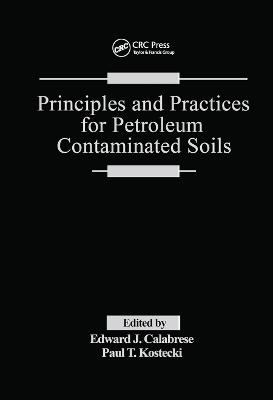
Principles and Practices for Petroleum Contaminated Soils
Routledge (Verlag)
978-0-367-45014-4 (ISBN)
Principles and Practices for Petroleum Contaminated Soils includes some of the best research and practical work done by top researchers in the field-both in industry and academia. It covers fundamental and advanced topics, such as analysis and site assessment, techniques (e.g., vacuum extraction, asphalt incorporation), and case studies. The book will interest anyone working with contaminated soils, ground water, and underground storage tanks. It will also be a valuable reference for regulatory personnel and environmental consultants at all levels.
Calabrese, Edward J.; Kostecki, Paul T.
Part 1: Analysis & Testing 1. Fingerprinting Petroleum Products: Unleaded Gasolines 2. Analysis of Petroleum Contaminated Soil and Water: An Overview 3. Differentiation of Crude Oil and Refined Petroleum Products in Soil 4. Onsite Analytical Screening of Gasoline Contaminated Media Using a Jar Headspace Procedure 5. Relationships Between Chemical Screening Methodologies for Petroleum Contaminated Soils 6. Electrochemiluminescent Sensing of Petroleum Contamination at Trace Levels 7. Why TCLP, EP-Tox, and the California WET Do Not Derive Data on the Mobility and Transformations of Metals in Soil Systems Part II: Environmental Fate and Modeling 8. Bioremediation of Petroleum Products in Soil 9. Mathematical Hydrocarbon Fate Modeling in Soil Systems 10. Petroleum Contaminated Soil: Chemistry and Modeling 11. The Utility of Environmental Fate Models to Regulatory Programs Part Ill: Remediation 12. An Evaluation of Organic Materials That Interfere with Stabilization/Solidification Processes 13. Incorporation of Contaminated Soils into Bituminous Concrete 14. Additive Stabilization of Petroleum Contaminated Soils 15. In Situ Vitrification Applications 16. Field Studies of In Situ Soil Washing 17. Land Treatment of Hydrocarbon Contaminated Soils 18. Low Temperature Stripping of Volatile Compounds 19. Barrier Walls to Contain Contaminated Soils 20. In Situ Biological Remediation of Petroleum Hydrocarbons in Unsaturated Soils 21. Estimates for Hydrocarbon Vapor Emissions Resulting from Service Station Remediations and Buried Gasoline-Contaminated Soils 22. Letting the Sleeping Dog Lie: A Case Study in the No-Action Remediation Alternative for Petroleum Contaminated Soils Part IV: Health Assessment 23. A Proposed Approach to Regulating Contaminated Soil: Identify Safe Concentrations for Seven of the Most Frequently Encountered Exposure Scenarios 24. Review of Present Risk Assessment Models for Petroleum Contaminated Soils 25. Creative Approaches in the Study of Complex Mixture
| Erscheinungsdatum | 03.12.2019 |
|---|---|
| Verlagsort | London |
| Sprache | englisch |
| Maße | 156 x 234 mm |
| Gewicht | 453 g |
| Themenwelt | Naturwissenschaften ► Biologie ► Ökologie / Naturschutz |
| Naturwissenschaften ► Geowissenschaften ► Geologie | |
| Technik ► Bauwesen | |
| Technik ► Umwelttechnik / Biotechnologie | |
| Weitere Fachgebiete ► Land- / Forstwirtschaft / Fischerei | |
| ISBN-10 | 0-367-45014-3 / 0367450143 |
| ISBN-13 | 978-0-367-45014-4 / 9780367450144 |
| Zustand | Neuware |
| Haben Sie eine Frage zum Produkt? |
aus dem Bereich


